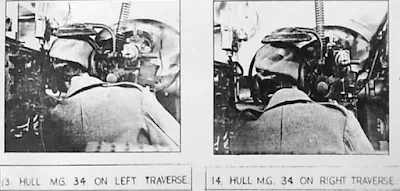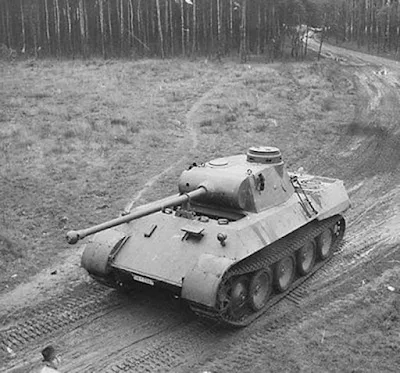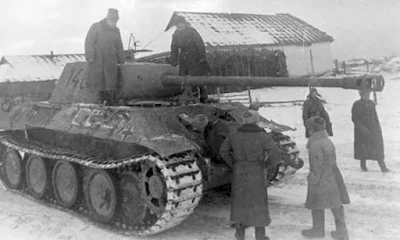 |
| Panther Ausf.D tank #433. The British received a tank from the USSR for testing long before they found one on their own. |
 |
| Calculated penetration of a Panther tank’s armor with a 17-pounder gun. In practice, it turned out that the armor was weaker than anticipated. |
 |
| Trials showed that even the Panther’s thick sloped upper front plate was not invulnerable, especially under repeated attack. |
 |
| The Panther’s engine deck presented a wealth of openings and slits that could be penetrated by shell splinters. |
 |
| Even relatively weak guns could penetrate the thin roof armor by ricocheting a shell downwards off the gun mantlet. |
 |
| Result of a hit to the gun mantlet with a 75 mm HE shell. The roof of the driver’s compartment caved in from the blast, which would likely have killed him. |
 |
| Significant cracking of the side armor as a result of being hit with 6-pounder shot. |
 |
| Damage to the front road wheel and track as a result of detonating a Mk.V H.C. mine. |
 |
| Breech of the 75 mm KwK 42 cannon. This was a powerful gun, but it was difficult to aim and load due to the design of the Panther tank. |
 |
| The radio operator had to lean his entire body to the left in order to fire the hull machine gun. |
 |
| American troops inspect a bogged down Panther tank. Despite its wide tracks, the Panther’s off-road performance left much to be desired. |
 |
| British troops inspect a knocked out Panther near Palazzo Guerrino, Italy. |
 |
| Panthers at a scrap yard in Italy near Rome. |
 |
| American troops gathered around a Panther tank stuck in a bomb crater. Normandy, July 1944. |
 |
| A Panther tank captured intact in Dompaire. |
 |
| One of the first images of the Panther tank widely distributed among the Allies. |
 |
| A Panther Ausf. D received from the USSR. |
 |
| The Panther tank on trials at the Fighting Vehicle Proving Establishment. Trials showed that this tank was extremely unreliable. |
 |
| The Panther tank before trials. |
 |
| Panther tank commander, Italy. |
 |
| Panther “534” followed by troops in a Sd.Kfz. 251 half-track, 5th SS Panzer Division “Wiking” in Poland. |
 |
| Panther “534” followed by troops in a Sd.Kfz. 251 half-track, 5th SS Panzer Division “Wiking” in Poland. |
 |
| Panther “800,” of the 5th SS Panzer Division “Wiking.” |
 |
| Unloading Panthers in Russia, 1944. |
 |
| Panther Ausf D in Rome. |
 |
| Another view of the same tank as in the previous photo. |
 |
| Another view of the same tank as in the previous photo. |
 |
| Panther disguised as an American M10 tank destroyer, Ardennes offensive, December 1944. |
 |
| Panther Ausf D camouflaged with foliage. |
 |
| Cupola of a Befehlspanzer Panther Ausf A. |
 |
| Inside view of the cupola on the Panther Ausf G. |
 |
| Panther Ausf A in Italy. |
 |
| A Panther Ausf G crewman on the lookout for enemy aircraft, Normandy, 1944. |
 |
| Panther Ausf D, Panzer-Regiment 4, I. Abteilung (I./Panzer-Regiment 26) 26. Panzer-Division. Italy, 1944. |
 |
| Panther “221”, SS-Pz-Rgt. 1, Kampfgruppe Peiper, La Gleize, Ardennes Offensive. |
 |
| Panther “221”, SS-Pz-Rgt. 1, Kampfgruppe Peiper, La Gleize, Ardennes Offensive. |
 |
| Panther “221”, SS-Pz-Rgt. 1, Kampfgruppe Peiper, La Gleize, Ardennes Offensive. |
 |
| GI inspecting knocked out Panther. |
 |
| GIs of the Ninth Army inspecting bombed out Panther tank factory, Hannover, Germany, 1945. |
 |
| Panther Ausf D ready for shipment. |
 |
| Early version of the Panther Ausf A with Zimmerit coating. |
 |
| The first Versuchs-Panther prototype, built in September of 1942. A dummy turret is installed (second from left). |
 |
| The Maybach HL 230 engine, initially used on the Panther and later on the Tiger. |
 |
| VK30.02(M) V2 on trials, likely at Kummersdorf. Notice the ball-shaped muzzle break, drive sprocket, and clean-cut side armor plates. |
 |
| VK30.02(M) V2 on trials, likely at Kummersdorf. Notice the bulge on the side of the turret which accommodates the cupola, and also the ladder on the side of the hull. |
 |
| VK30.02(M) V2 on trials, likely at Kummersdorf. Notice the license plate held on with wire. |
 |
| VK30.02(M) V2 on trials, likely at Kummersdorf. |
 |
| VK30.02(M) V2 on trials, likely at Kummersdorf. |
 |
| An enhanced version of the previous photo. The three return rollers and unfinished suspension are easier to see. |
 |
| Verschus-Panther (Fgst.Nr. V1) driving over a wave road in 1944. The single bicycle tire on a vertical track mounted to the side of the tank is a system for measuring vibration. |
 |
| Close-up view of the vibration measuring device. |
 |
| Rear view of the Rheinmetall-Borsig turret and 7.5cm cannon mounted on the VK45.01(H2) wooden mockup. |
 |
| The second, third, and fifth unfinished hulls are Pz.Kpfw. Panther Ausf.F hulls mixed in with Pz.Kpfw. Panther Ausf.G hulls. |
 |
| “Schmalturm” on a test rig was a projected turret for the second generation Panther. In spite of being lighter and smaller, it was designed to take a larger gun. |
 |
| A Panther Ausf. G (early) picking up men equipped with the Wien 41 mine detector, France, 1944. |
 |
| Panther breaks through a wooden bridge. |
 |
| PzKpfw V, 438, SS-Uscha Gerhard Mahlke, 12th SS Panzer Division, Fontenay-le-Pesnel, June 25, 1944. |
 |
| Panzerkampfwagen V Ausf. D Panther and crew. This tank is riddled with shell impacts of all sizes. |
 |
| Panther 37mm Flak 43. |
 |
| Panther 37mm Flak 43. |
 |
| American GI examining destroyed Pantherturm. |
 |
| Pantherturms on railcars ready for shipment. |
 |
| Pantherturm dug in on the side of the Aquino-Pontecorvo road. Knocked-out tanks can be seen in the distance. Took out three tanks before it was knocked out. |
 |
| Buried Panther tank in a Berlin intersection, 1945. |
 |
| Another view of the same buried Panther tank. |
 |
| Panzerbefehlswagen V “Panther” commander’s tank with additional radios and aerials. |
 |
| Panthers ‘831’ and ‘832’, 5th SS-Panzer-Division “Wiking,” July 1944. |
 |
| Panther Ausf A ‘221’. |
 |
| Panzerbefehlswagen V “Panther” destroyed by 101st Airborne in Erf, Holland, Market Garden, 23 September 1944. |
 |
| Knocked-out Panther Ausf G, ‘302’. |
 |
| Captured Panther ‘146’, commander’s cupola, Eastern Front. |
 |
| Panther Ausf G, ‘215’, Czechoslovakia, 1945. |
 |
| Panzerbefehlswagen V “Panther” Ausf D with zimmerit. |
 |
| Pantherturm II, Berlin, 1945. |
 |
| Panther ‘322’, Eastern Front, 1943. |
 |
| Captured Panther ‘146’, Eastern Front. |
 |
| Pantherturm. |
 |
| Panther Ausf A ‘143’. |
 |
| Panther ‘II02’. |
 |
| The same Panther seconds later. |
 |
| Panther Ausf A ‘II00’, 23rd Panzer Division. |
 |
| Panther Ausf D ‘224’. |
 |
| White-washed Panthers Ausf A ‘111’ and ‘112’. |
 |
| Captured Panther ‘146’, Eastern Front. |
 |
| Panther ‘821’, Eastern Front. |
 |
| Early Panther ‘18’. |
 |
| Panther Ausf A ‘204’, I/SS Panzer Regiment 12, Tessel, Normandy. |
 |
| Knocked-out Panthers Ausf G, Krinkelt, Belgium, Battle of the Bulge, 17 December 1944. |
 |
| Panthers Ausf G, Hungary, 1944. |
 |
| 75th Infantry Division GI with Panther Ausf G, Grandmenil, 30 December 1944. |
 |
| Panther ‘200’. |
 |
| Panther Ausf D ‘232’, 2nd SS Panzer Division “Das Reich”. |
 |
| WACs inspecting knocked-out Panther Ausf G, Paris, 1944. |
 |
| Panthers, 116th Panzer Division, 1944. |
 |
| Abandoned Panther Ausf D. |
 |
| Knocked-out Panther Ausf A, Tilly sur Seulles, 1944. |
 |
| Captured Panther ‘732’, 1943. |
 |
| Panther Ausf G ‘424’, France, 1945. |
 |
| Panther Ausf A ‘823’, 5th SS Panzer Division “Wiking”. |
 |
| Panther Ersatz M10, Belgium, Battle of the Bulge, December 1944. |
 |
| Panther ‘107’. |
 |
| Early Panther ‘19’. |
 |
| Panther and captured T-34, Minsk Bolshevik factory, 1944. |
 |
| Panther under recovery by M32 TRV, 11th Armored Division, outside of Walferdange, Luxembourg, 13 February 1945. |
 |
| Panther Ausf D ‘824’ captured near Kursk, July 1943. |
 |
| Panthers, 116th Panzer Division, 1944. |
 |
| Captured Panther Ausf D, 1943. |
 |
| Panther Ausf D ‘I03’. |
 |
| Knocked-out Panther Ausf D, Italy, 1943. |
 |
| Panther Ausf A, 5th SS Panzer Division “Wiking”, winter 1944. |
 |
| Destroyed Panthers Ausf A, Anzio, 1944. |
 |
| Captured Panther Ausf D ‘445’, Panzergrenadier Division “Großdeutschland”, August 1943. |
 |
| Captured Panther, Voznesensk, Ukraine, 1944. |
 |
| Panther Ausf A and SdKfz 251/7, 5th SS Panzer Division “Wiking”. |
 |
| Panther, SdKfz 251 and Schwimmwagen, 5th SS Panzer Division “Wiking”. |
 |
| Panther ‘324’. |
 |
| Panther Ausf G. Mountings and electrical connectors for the infrared searchlight were mounted on the side of the gun mantlet. One can also see the rather crude way of applying the Zimmerit paste. |
 |
| Details seen on this Panther Ausf G include the upgraded mantlet with the elimination of the shot trap area. |
 |
| Flak Panther Ausf. D, s.Pz.Abt.653. |
 |
| Destroyed Panther tanks from the 11th Panzer Division, France, 1944. |
 |
| M25 Tank Transporter moving a PzKpfw. V “Panther” tank, Germany, post-war. |
 |
| M4A3 Sherman passing a knocked out Panther in the northern salient of the Bulge, c. January 1945. |
 |
| French civilians inspect a destroyed German Panther tank on the banks of the Seine River, Paris, August 1944. |
 |
| Tracks being fitted to a Panther tank in a factory in Germany. |
 |
| VK 30.02 (M) prototype medium tank—one of the direct prototypes of the famous Panther tank. |
 |
| Panzerkampfwagen V Panther “800” with SdKfz 251. |
 |
| American soldiers pose alongside a Panther tank with a captured German flag, Normandy, June 1944. |
 |
| PzKpfw V “Panther.” |
 |
| Panther "501". |
 |
| A soldier inspects a burnt out Panther near Trarivi in the Adriatic sector, 18 September 1944. |
 |
| The first Versuchs-Panther prototype, built in September 1942. A dummy turret is installed. |
 |
| Trials of the VK 20.01(D) in winter. |
 |
| Nonstop bombings played a role in the failure of German production plans. |
















No comments:
Post a Comment